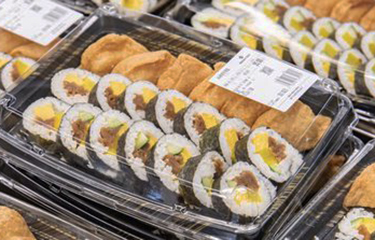Cincinnati, Ohio, U.S.A.-based Kroger, the country’s largest grocery chain operator, with more than 2,700 grocery stores, has become the top seller of sushi in the U.S.
Kroger sold 44 million sushi rolls in 2022, a spokesperson told Business Insider, even though Kroger only sells sushi at two-thirds of its outlets.
The company, which reported an operating profit of USD 4.1 billion (EUR 3.7 billion) on USD 148.3 billion (EUR 136.6 billion) in sales in 2022 – and which entered into a merger agreement with Albertsons in October 2022 – has ridden a national wave of demand for sushi and other prepared, ready-to-eat products sold at retail, according to the Wall Street Journal.
Sales of sushi across the U.S. retail sector have soared 72 percent by value and 50 percent by volume over the past four years, a spokesperson for research firm Circana told SeafoodSource.
Snowfox/JFE Franchising, which was recently purchased by Zensho Holdings and which operates more than 2,300 sushi kiosks globally, has also benefitted as a primary sushi supplier for Kroger, Costco, and other major U.S. retailers.
Kroger has capitalized on Americans’ desire for new flavors, adding crunchy combo and spicy combo boxes to its lineup of sushi offerings. Kroger’s California crunch roll is its most popular cooked sushi roll, and its rainbow roll is its most popular raw offering. At Ralphs, a chain in Southern California owned by Kroger, Latin-fusion rolls topped with sweet mango sauce are popular.
"When customers think of sushi, we want them to think of Kroger," Kroger Chief Marketing Officer Stuart Aitken said.
However, as inflation-weary U.S. shoppers suffer from sticker shock, sales of sushi at retail have waned slightly.
Retail sushi sales increased just 0.4 percent by value for the year ending 13 August, 2023, according to Circana, while sales by volume dropped 3.9 percent. For the most recent quarter, grocery sushi sales by value decreased by 0.1 percent while sales volumes declined by 3.8 percent.
Nielsen found the average price per unit for sushi spiked 14.2 percent for the 12 months ending 13 May, and the per unit price was up 3.8 percent for the quarter ending 13 August to USD 9.29 (EUR 8.65) per unit on average.
The price increase has caused some erosion in demand, with units down by 1 percent, according to Category Partners Senior Vice President of Marketing Eric Le Blanc.
“It certainly could be the case that shoppers are keeping tighter rein on their higher dollar purchases and are cutting back on the frequency of their sushi purchases for lower-cost alternatives,” he said.
Kroger did not respond to SeafoodSource’s requests for comment on its sushi sales, but Le Blanc said the future remains bright for sushi sold at retail.
“Sushi growth has been explosive over the past few years and certainly benefited during the pandemic,” Le Blanc told SeafoodSource in June. “Clearly, sushi has not reached the end of its growth trajectory, even though the total market is leveling off.”
Photo courtesy of Kroger







